Last week I wrote a post about a gotcha that can trip people up as they’re building campaigns in Keap. Well, this week I want to tackle another common misunderstanding I see.
By default, what happens when a goal is achieved?
- The sequence before it is stopped.
- The sequence after the goal is started.
This brings us to gotcha number two.
NOTE: To cover this gotcha in with the level of detail it deserves, this blog got a little longer than I anticipated. So, I recorded a quick video overview as well, if that’s more your speed, scroll to the bottom for the TL;DR version.
Gotcha #2:
The key part of that question above is “by default”.
And the reason I’m emphasizing that phrase is because that isn’t always the case.
Keap has specific sequence settings, and goal settings that can affect the expected behavior, and can make number one or number two above untrue.
If you don’t thoroughly understand the different settings, then it’s really easy to think you have things figured out, and be totally caught off guard when something doesn’t work the way you expected.
First, let’s talk about sequence settings.
Have you ever noticed how each sequence in your campaign has a little badge in the lower left hand corner?
By default, it looks like a white flag on a blue background. This little graphic is the indicator as to whether or not this sequence will stop when a goal downstream is achieved, or whether it will keep going.
If you ever went to the dentist as a kid, you probably remember paging through Highlights magazine while in the waiting room – and if you were like me, you took great pride in your ability to dominate the “Spot the Differences” game.
You know, they’d show you two similar images, and your job was to identify that in one picture the kid had an extra freckle, or an untied shoelace.
Anyway, this is kind of like that. The campaign is identical, with the exception of the little colored badge on the lower left hand corner of the sequence.
In the first image the sequence WILL stop when Goal A is achieved, in the second sequence it WON’T stop when Goal A is achieved.
The reason this confuses people isn’t because it happens frequently. Most people have never clicked on that flag, and have never changed this setting:
I’m covering this here because it breaks the commonly accepted rule “sequences stop when goals are achieved”. When things break the rules we’re used to, it can get confusing.
Now, the natural question at this point is “Why wouldn’t I want my sequence to stop?” – and the best answer to that is that sometimes you’ve set certain expectations, and you need to deliver on what you said you’d do.
Like in this campaign here:
If we’ve set the expectation that we were going to send someone ten tips, well, even if they buy the upsell we’re offering, we still want to deliver the ten tips we’ve promised. (Yes, there are dozens of other ways to handle this specific scenario, but I’m illustrating a point here guys…)
If you find this type of stuff valuable, or you want a place to ask questions – then you might get a lot of value from our private community. Check out the OG Membership details here >>
Okay, let’s move on to the second half of this Gotcha. Goal Settings.
When a goal is achieved, a contact starts the sequence following the goal, right?
Well, yes. Normally. But again, there is a setting that controls this. You see, goals work either globally, or locally. By that I mean they can either be configured for all contacts anywhere, or only for contacts who are already in that campaign.
What this means is that you can build goals that are listening for anyone anywhere, but you can also build goals that are only listening for contacts already in that campaign to take an action. The global goals are commonly referred to as “entry points”.
Trust me, this sounds a lot more complicated than it actually is.
Let’s look at a few examples:
We’ll start with a really easy one. In the above scenario, if any contact achieves Goal A, they will be added to Sequence 1. In this scenario, this goal is considered an entry point to the campaign because there isn’t anything prior to it. So, if a goal doesn’t have a sequence before it, then it is automatically an entry point, and is fair game for any contact.
But for goals that are “landlocked”, they are not naturally entry points. Check this one out:
In this scenario, if someone requests my whitepaper, they’ll get the whitepaper delivered in the next sequence, and then they’re driven to purchase, and after the purchase they’ll get some sort of thank you.
But, if someone buys my coaching package who is not in this campaign, then they will not be added to the thank you sequence. The purchase goal is landlocked, and is not currently an entry point. So that means that the goal is only listening for purchases from the group that is already in this campaign.
Again, the natural question is: “Wouldn’t I want the thank you sequence to go to all people who buy, even if they skip the whitepaper part?” And the answer is that “Yeah, you probably would”.
But what if you wanted to have some sort of specific follow up, and you wanted to craft your thank you message to be really specific. Something like:
“Hey, thanks for buying my coaching package. As you probably saw in the whitepaper, I’m really focused on three things, X, Y and Z. And this coaching package is the perfect way to take the methodologies I talked about in the whitepaper and translate them into results for your business.”
Well, the way it’s currently configured, you could be that specific because you know the only people who can get into the “Thanks” sequence, are those who also came through the whitepaper sequence.
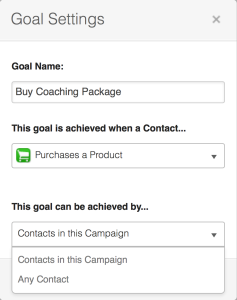 But, let’s say for a moment that you didn’t want that. Well, if you click on the colored badge in the lower left hand corner of any goal, you can denote whether or not you want that goal to be an entry point. It’s called Goal Settings.
But, let’s say for a moment that you didn’t want that. Well, if you click on the colored badge in the lower left hand corner of any goal, you can denote whether or not you want that goal to be an entry point. It’s called Goal Settings.
This one little setting is often overlooked, but it can be really useful for your more complex campaigns; where you may need to have multiple entry points throughout the campaign.
One thing to note, is that some goal types don’t permit you to make the goal an entry point.
For example, link click goals, and task completion goals don’t allow you to configure them as entry points, because in order for someone to achieve one of those goals they would have to have been in the sequence prior to the goal.
Additionally, if there isn’t a sequence prior to the goal, it also won’t let you set it as an entry point. It’s an entry point by default.
So, now that we’ve changed the goal setting, let’s take a look at that same campaign.
You should notice that the Purchase goal now has a visual indicator letting us know that it’s now an entry point. The little icon in the top right, a dude with a green arrow, shows us that contacts can achieve that goal, and be added to the campaign at that point.
Okay, so, here’s the last twist to all this.
When we talk about a “Campaign” – we’re talking about EVERYTHING that is on the same canvas. So that means if they are anywhere in the campaign, that all goals in that campaign are considered entry points. Even if they are seemingly unrelated, and there’s no connecting lines between them at all.
Here’s an example:
This is one campaign. Even though there are separate and parallel processes, because they’re built on the same campaign builder canvas, the system thinks of them as being the same campaign. So, if someone is in Sequence 1, and they achieve the Purchase Goal, they’ll not only stay in sequence 1, but they’ll also start Sequence Y.
Okay. Like I said originally, this sounds more complex that it actually is.
What I’ve found with things like this, is that it can be hard to understand these concepts before you actually need them because the information seems rather abstract.
So, that’s why I’ve included so many examples, with the hopes that if you come across one of these you’ll have an idea of what the expected behavior looks like.
But please, ask questions if you’re unclear on any of this. I’m happy to elaborate.
If you love this stuff, and you want to dive deeper, I strongly recommend checking out the Advanced Automations Complete Collection course from Keap Academy, covering the fundamental basics and bells and whistles – everything you need to know about the campaign builder.
Oh, and if you’re the type of person who prefers a video tutorial, here’s an overview:

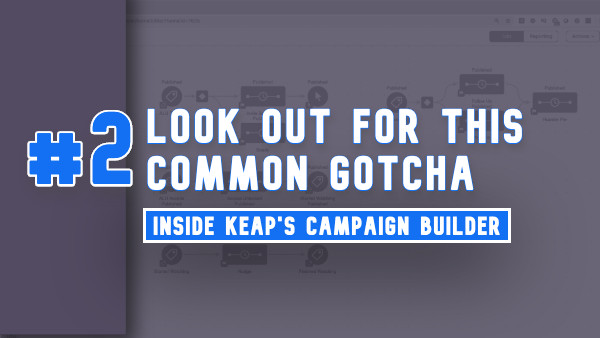
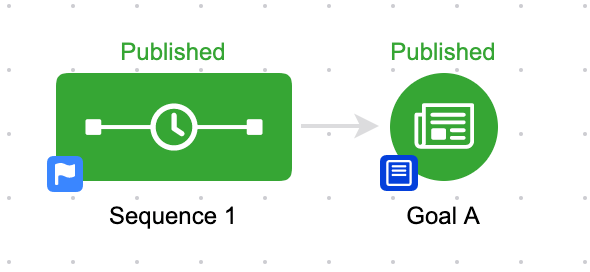
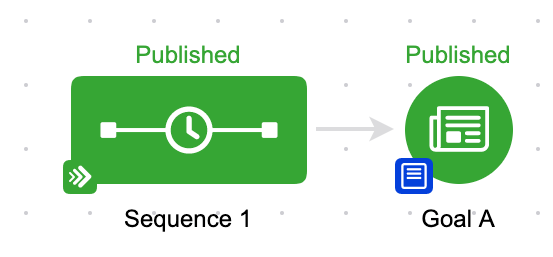
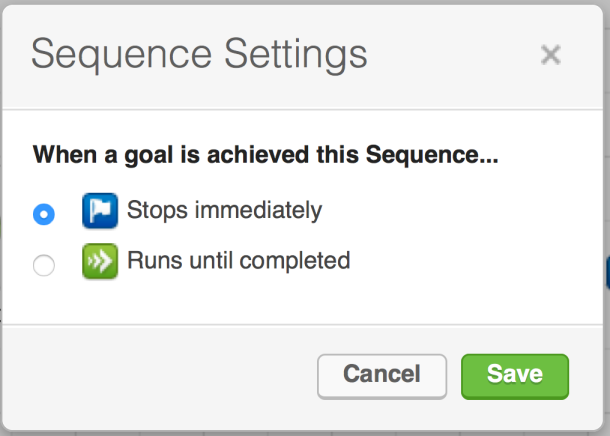
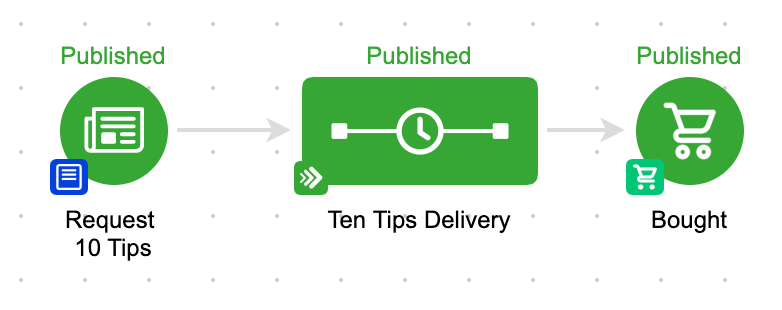
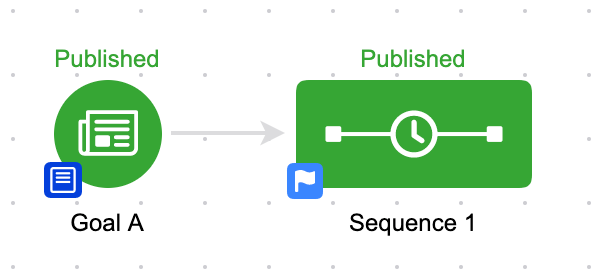


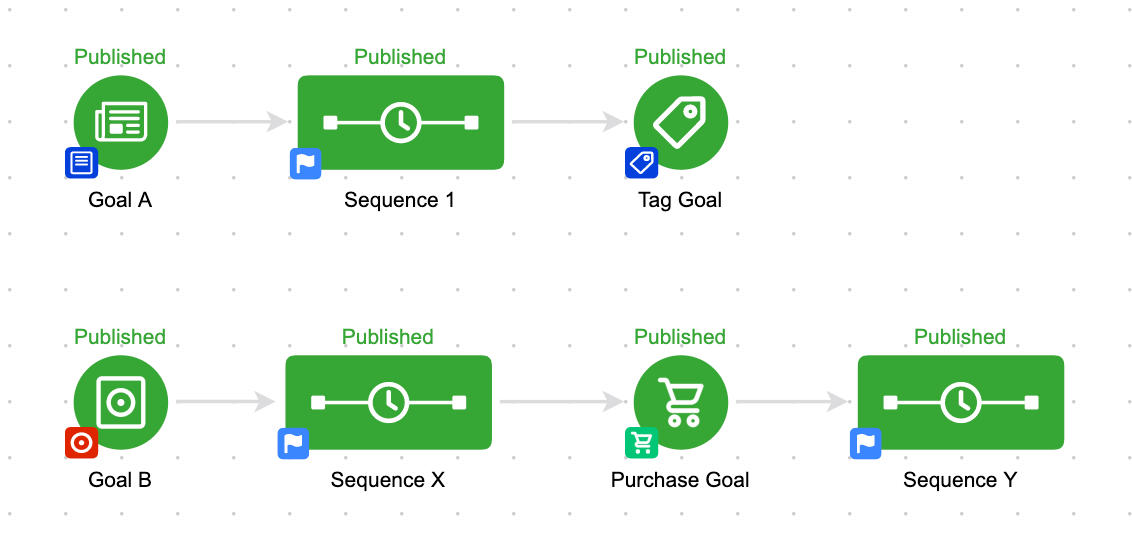




Greg,
Awesome stuff here, the video was a GREAT add – as I was certainly a TLDR. I was trying to explain this to a person just yesterday (who now has a link to this post).
These are little things, but they can make a HUGE difference when you’re really trying to do the right thing and segment and talk to people as individuals. Keep up the awesome work!
Thanks man! I agree. It’s not rocket science, but it’s also not necessarily “obvious”. I find that more people than I expected appreciate these nuances, even if it’s just to confirm what they already “knew”. Thanks for reading and sharing Kev.